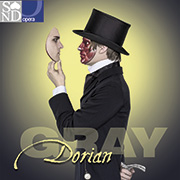That which appears to be beautiful does not have to be good. Ľubica Čekovská and her librettist took Oscar Wilde’s inspired tale as their starting point, and with Dorian Gray have created an opera which poses major questions.
Oscar Wilde’s The Picture of Dorian Gray, the timelessly relevant story of appearance versus reality, is the subject of Ľubica Čekovská’s first opera. The Slovak composer wrote the full-length work to a libretto by Kate Pullinger in response to a commission from the National Theatre Bratislava. “The main theme is the dualism at the heart of the story – of good and evil, dark and light, poor and rich”, says the librettist. “Dorian belongs to two separate worlds – high society, bright, glittering and glamorous, and a dark, veiled underworld in London’s docklands, with sex, drugs and gambling. This dualism shapes the entire libretto of the opera Dorian Gray.” The richly detailed plot in Oscar Wilde’s novel (1890), which at the same time portrays a picture of bigoted Victorian society, is concentrated in the opera into a compelling sequence of scenes in three acts. Dorian’s descent into depravity begins with his fatal promise to the seducer Lord Henry and betrayal to the actress Sybil Vane.
The enigma and key to the story is “The Picture” which ages as a depiction of Dorian Gray and assumes the characteristics of his fall and its cruelty. Čekovská shapes this as a musical cipher for the destiny of the fallen angel. It is symbolized by eight unaccompanied boys’ voices in a simple melody unfolding over a drone. “The voices of the picture” constantly reappear in the course of the plot, but are increasingly distorted and darkened until they are just a grotesque reflection of the pure vocal line of the beginning. “This melodic line is an emblem for the whole opera, in which singability and the communication between voice and orchestra is particularly important for me”, says Čekovská. The contrasts within the plot also characterise the composition: simplicity is juxtaposed with complexity.
The story of Dorian Gray invites audiences to contemplate the essence of beautiful appearances. For what appears to be beautiful is not necessarily also good. And when this happens within the framework of a work of art, an opera, its own artistry automatically becomes the theme. “In this short melody and its development, I play with the meanings of beauty and with the ambiguity of this concept”, says Čekovská. This also happens in that the composer works with the different stylistic levels of the music. The world of the elegant salon, the theatre, the underworld, is made manifest to the senses by appropriate musical styles and culminates in an orgiastic scene, oriental in atmosphere. In order to tell the story vividly, in the crowd scenes Čekovská contrasts cheap, angular, strident echoes of circus, theatre and salon music with an increasingly dark prevailing mood, and plays with the dualism of extremely bright colours and an increasingly dramatic intensity. As in all her works, in the process she develops the musical flow consistently from limited motivic material. And as the dominant theme in the dramatic sense, the beauty of the voice and the vocal line is at the centre of her work.
The figure of Dorian Gray, who sacrifices everything for the beautiful appearance of his own face and absorbs the most varied influences without having a position of his own – from the mephistophelian Lord Henry, via the idealistic artist Basil to the crooks of the underworld – is more relevant than ever for Čekovská: “When the glittering surface becomes the all-determining factor, when supernaturally beautiful people are society’s ideal today, when we are only concerned with how beautiful someone is and not about who or how he or she is, then the questions which are posed in the story of Dorian Gray are more pressing than ever.”
Marie Luise Maintz
(from [t]akte 2/2013)



